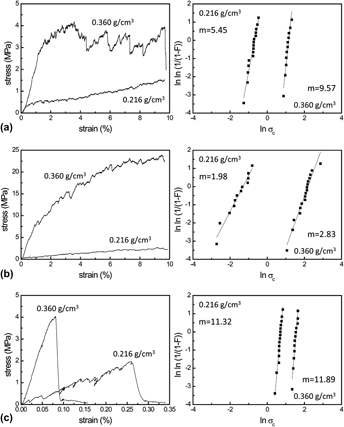Crossref Citations
This article has been cited by the following publications. This list is generated based on data provided by
Crossref.
Ji, Haipeng
Huang, Zhaohui
Wu, Xiaowen
Huang, Juntong
Chen, Kai
Fang, Minghao
and
Liu, Yan’gai
2014.
Preparation, microstructure, and compressive strength of carbon foams derived from sucrose and kaolinite.
Journal of Materials Research,
Vol. 29,
Issue. 8,
p.
1018.
Sciamanna, V.
Nait-Ali, B.
and
Gonon, M.
2015.
Mechanical properties and thermal conductivity of porous alumina ceramics obtained from particle stabilized foams.
Ceramics International,
Vol. 41,
Issue. 2,
p.
2599.
Tikhov, Serguei F.
Sadykov, Vladislav A.
Valeev, Konstantin R.
Salanov, Aleksey N.
Cherepanova, Svetlana V.
Bespalko, Yulia N.
Ramanenkau, Vladimir E.
Piatsiushyk, Yavgenii Ya.
and
Dimov, Sergey V.
2015.
Preparation of porous ceramometal composites through the stages of mechanical activation and hydrothermal partial oxidation of Me–Al powders.
Catalysis Today,
Vol. 246,
Issue. ,
p.
232.
Sarkar, Naboneeta
Lee, Kee Sung
Park, Jung Gyu
Mazumder, Sangram
Aneziris, Christos G.
and
Kim, Ik Jin
2016.
Mechanical and thermal properties of highly porous Al 2 TiO 5 –Mullite ceramics.
Ceramics International,
Vol. 42,
Issue. 2,
p.
3548.
Tikhov, S. F.
Andreev, A. S.
Salanov, A. N.
Cherepanova, S. V.
Lapina, O. B.
Sadykov, V. A.
Tanashev, Yu. Yu.
and
Bolotov, V. A.
2016.
Ceramic matrix composites prepared from CoAl powders.
Journal of Materials Science,
Vol. 51,
Issue. 23,
p.
10487.
Seuba, Jordi
Deville, Sylvain
Guizard, Christian
and
Stevenson, Adam J.
2016.
The effect of wall thickness distribution on mechanical reliability and strength in unidirectional porous ceramics.
Science and Technology of Advanced Materials,
Vol. 17,
Issue. 1,
p.
128.
Ferraro, Claudio
Garcia‐Tuñon, Esther
Rocha, Victoria G.
Barg, Suelen
Fariñas, Maria Dolores
Alvarez‐Arenas, Tomas E. Gomez
Sernicola, Giorgio
Giuliani, Finn
and
Saiz, Eduardo
2016.
Light and Strong SiC Networks.
Advanced Functional Materials,
Vol. 26,
Issue. 10,
p.
1636.
Salvini, Vânia R.
Lasso, Paulo R. O.
Luz, Ana P.
and
Pandolfelli, Victor C.
2016.
Nontoxic Processing of Reliable Macro‐Porous Ceramics.
International Journal of Applied Ceramic Technology,
Vol. 13,
Issue. 3,
p.
522.
ALI, Mohammed Sabah
HANIM, M. A. Azmah
TAHIR, S. M.
JAAFAR, C. N. A.
NORKHAIRUNNISA, M.
and
MATORI, Khamirul Amin
2017.
Preparation and characterization of porous alumina ceramics using different pore agents.
Journal of the Ceramic Society of Japan,
Vol. 125,
Issue. 5,
p.
402.
Fey, Tobias
Betke, Ulf
Rannabauer, Stefan
and
Scheffler, Michael
2017.
Reticulated Replica Ceramic Foams: Processing, Functionalization, and Characterization.
Advanced Engineering Materials,
Vol. 19,
Issue. 10,
Hubálková, Jana
Voigt, Claudia
Schmidt, Anne
Moritz, Kirsten
and
Aneziris, Christos G.
2017.
Comparative Phenomenological Study of Fracture Behavior of Ceramic and Glass Foams under Compressive Stress Using In Situ X‐Ray Microtomography.
Advanced Engineering Materials,
Vol. 19,
Issue. 9,
Tikhov, S.
Minyukova, T.
Valeev, K.
Cherepanova, S.
Salanov, A.
Kaichev, V.
Saraev, A.
Andreev, A.
Lapina, O.
and
Sadykov, V.
2017.
Design of micro-shell Cu–Al porous ceramometals as catalysts for the water–gas shift reaction.
RSC Advances,
Vol. 7,
Issue. 67,
p.
42443.
Ali, Mohammed Sabah
Hanim, M. A. Azmah
Tahir, S. M.
Jaafar, C. N. A.
Mazlan, Norkhairunnisa
and
Amin Matori, Khamirul
2017.
The Effect of Commercial Rice Husk Ash Additives on the Porosity, Mechanical Properties, and Microstructure of Alumina Ceramics.
Advances in Materials Science and Engineering,
Vol. 2017,
Issue. ,
p.
1.
Tikhov, S. F.
Mel’gunova, E. A.
Mel’gunov, M. S.
Bespalko, Yu. N.
Valeev, K. R.
Shmakov, A. N.
Sadykov, V. A.
Romanenkov, V. E.
Petyushik, E. E.
and
Evtukhova, T. A.
2017.
Modification of the structural, textural, and mechanical properties of an Al2O3/Al composite on the addition of an Al-SBA-15-type mesoporous phase.
Inorganic Materials,
Vol. 53,
Issue. 12,
p.
1322.
Salvini, Vânia Regina
Pandolfelli, Victor C.
and
Spinelli, Dirceu
2018.
Recent Advances in Porous Ceramics.
Rowthu, Sriharitha
Saeidi, Fatemeh
Wasmer, Kilian
Hoffmann, Patrik
and
Kuebler, Jakob
2018.
Flexural strength evaluations and fractography analyses of slip cast mesoporous submicron alumina.
Ceramics International,
Vol. 44,
Issue. 5,
p.
5193.
Ferraro, Claudio
Garcia-Tunon, Esther
Barg, Suelen
Miranda, Miriam
Ni, Na
Bell, Robert
and
Saiz, Eduardo
2018.
SiC porous structures obtained with innovative shaping technologies.
Journal of the European Ceramic Society,
Vol. 38,
Issue. 3,
p.
823.
Alzukaimi, Julian
and
Jabrah, Rafi
2019.
The preparation and characterization of porous alumina ceramics using an eco‐friendly pore‐forming agent.
International Journal of Applied Ceramic Technology,
Vol. 16,
Issue. 2,
p.
820.
Carstens, Simon
Dammler, Kathleen
Scheffler, Michael
and
Enke, Dirk
2019.
Reticulated Alumina Replica Foams with Additional Sub‐Micrometer Strut Porosity.
Advanced Engineering Materials,
Vol. 21,
Issue. 12,
Wang, Qiuyu
Xue, Kaicheng
Fu, Ping
Du, Feipeng
Lin, Zhidong
Chen, Zhe
Wang, Shenggao
and
Wang, Geming
2019.
Tunable dielectric properties of porous ZnAl2O4 ceramics for wave-transmitting devices.
Journal of Materials Science: Materials in Electronics,
Vol. 30,
Issue. 7,
p.
6475.





